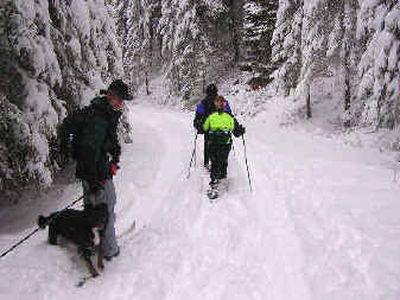Snow-packed fun

‘Would there be enough snow to make this drive to Mount Adams worth it?” I wondered as we drove across The Dalles Dam bridge.
The beginning of winter has been a bit depressing for skiers, with ski resorts opening later than anticipated or with limited runs. The weather reports seemed favorable, but our hopes could easily melt away in the rain.
Husband John seemed pretty confident and had given a good waxing to our battered skis.
Turns out he wasn’t alone. A lot of other snow lovers with eager hopefulness had come out to play this day in Washington’s Gifford Pinchot National Forest for the first good snow in weeks.
Clouds hung on the rim of the Columbia River Gorge. It was clear at the river’s surface and we could see up the gorge for miles at some turns (or viewpoints) as we moved along Highway 14, paralleling the river. Everything had a blue-grey hue to it, the kind of cool, solemn winter blue that settles upon a landscape when snow clouds block out the sun.
We turned north onto Highway 141 and drove upward, away from the Columbia and toward Mount Adams. This highway passes through the Trout Lake Valley. The valley and surrounding mountain range were home to Native Americans for thousands of years. Today, the eastern slope of Mount Adams is located within the Yakama Indian Reservation.
The first white settler in the valley was Swiss native Peter Stoller, who moved his family from Washington’s Gilmer Valley. It was just one valley over from Trout Lake, but the lack of paved roads made it an ordeal to set up a homesite in 1880. The family walked and drove a herd of 20 cattle from Gilmer to Trout Lake.
Stoller wrote home to friends in Switzerland, telling them of the little valley he found that reminded him of home. Some joined him.
On this day the valley’s pastures were smooth white. We spotted a couple of locals using their snowmobiles to get around their rural neighborhood, which had received a good dumping over the holidays. (A snowmobile is probably a good investment for those who live in high snow-volume regions of the globe. You may need it to go check the mail.)
The closer we got to Pineside Sno Park, the more hopeful I felt. Snow was all around us, and the parking area was busy. People were suiting up to hit the trail or packing it up for the day. We begin to adjust straps and cords on our own winter clothes and equipment.
Our mutt Kah-less got to try on his new dog boots. I never thought I would be shopping for dog shoes. The shoes protect the dog’s feet from being cut on ice. (Believe me, I would not be torturing my dog for nothing.)
Unfortunately, Kah-less’ shoes were too big. They looked like clown shoes on him. He ran across the plowed parking lot, making a slapping noise on the frozen ground. The snow on the trail was soft and powdery, not icy and sharp, so we left the shoes behind and made a mental note to take Kah-less shoe shopping next week.
I paused to watch some families playing on a sledding hill near the Big Tree Loop’s trailhead. The trail, which is a little over five miles, begins with a hill but levels off soon after. There are several hills on this trail, but nothing too steep, although it seems like it when you’re climbing sometimes.
We see many people on the trail – a group of young teenagers snowshoeing, couples skiing together, two fast, athletic guys speeding past us. Kah-less met a 1-year-old, yellow dog. They bounded and wrestled together in the snow before we continued on to our lunch-break spot at Washington’s oldest Ponderosa pine.
A wooden sign lists the tree’s measurements: 84-inch diameter, 202 feet in height and a volume of 22,000 board feet. Standing at the tree’s base, I looked straight up the trunk into the high branches where clumps of snow rested on green needles.
John cleared snow off the corner of a picnic table located at the Big Tree. Kah-less was ready for water and John and I were ready for a sugary snack.
After lunch, we skied on and turned left onto a section of the trail that is shared with snowmobilers. We took advantage of the wide, groomed area where the motorized vehicles had been and coasted easily down the hill, gaining speed when we wanted.
The trail diverges back onto the main cross-country ski path, leading two miles back to Pineside Sno Park. We crossed the Skamania County line on this stretch.
The beginning hill was a good ending. My muscles and lungs felt worked and alive. Tomorrow morning I will be sore.
Inside the car it was mostly quiet as we retraced our route back home to The Dalles. Everyone will sleep soundly tonight, and look forward to our next trip to one of our favorite ski spots.